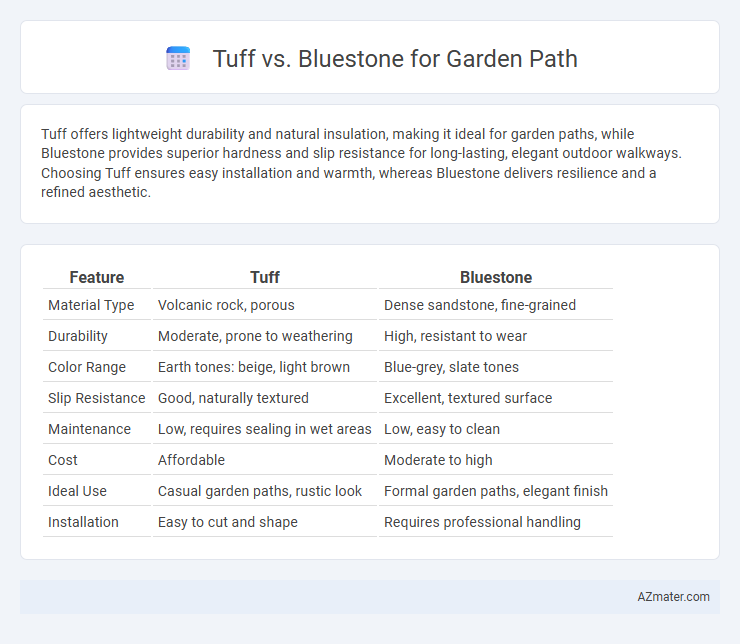Tuff offers lightweight durability and natural insulation, making it ideal for garden paths, while Bluestone provides superior hardness and slip resistance for long-lasting, elegant outdoor walkways. Choosing Tuff ensures easy installation and warmth, whereas Bluestone delivers resilience and a refined aesthetic.
Table of Comparison
| Feature | Tuff | Bluestone |
|---|---|---|
| Material Type | Volcanic rock, porous | Dense sandstone, fine-grained |
| Durability | Moderate, prone to weathering | High, resistant to wear |
| Color Range | Earth tones: beige, light brown | Blue-grey, slate tones |
| Slip Resistance | Good, naturally textured | Excellent, textured surface |
| Maintenance | Low, requires sealing in wet areas | Low, easy to clean |
| Cost | Affordable | Moderate to high |
| Ideal Use | Casual garden paths, rustic look | Formal garden paths, elegant finish |
| Installation | Easy to cut and shape | Requires professional handling |
Introduction: Choosing the Right Stone for Your Garden Path
Selecting the ideal stone for a garden path involves evaluating durability, aesthetic appeal, and maintenance requirements, with Tuff and Bluestone being popular options. Tuff, a lightweight volcanic rock, offers ease of installation and natural textures, while Bluestone provides dense, fine-grained surfaces known for strength and rich blue-gray hues. Garden paths made from Tuff emphasize a rustic charm, whereas Bluestone paths deliver a more polished, elegant look, influencing both functionality and landscape design.
What is Tuff? Key Characteristics and Benefits
Tuff is a type of volcanic rock formed from consolidated volcanic ash, characterized by its lightweight yet durable nature, making it ideal for garden paths. Key characteristics include its porosity, ease of cutting, natural textured surface, and resistance to weathering, which enhances traction and aesthetics. Benefits of using tuff in garden paths include improved drainage, low maintenance, and a unique rustic appearance that blends seamlessly with natural landscapes.
What is Bluestone? Key Characteristics and Benefits
Bluestone is a dense, natural sandstone known for its durability and attractive blue-gray hue, making it a popular choice for garden paths and outdoor paving. Key characteristics include its slip-resistant surface, weather resistance, and ability to withstand heavy foot traffic, ensuring longevity in various climates. Benefits of bluestone include low maintenance requirements, aesthetic versatility that complements diverse landscape designs, and its eco-friendly, natural composition.
Durability Comparison: Tuff vs Bluestone
Tuff offers moderate durability, suitable for garden paths with light to medium foot traffic, but may be prone to weathering and erosion over time. Bluestone, composed of dense sandstone or limestone, provides superior durability with high resistance to wear, frost, and moisture, making it ideal for long-lasting garden paths. For enduring strength and minimal maintenance in garden pathways, bluestone outperforms tuff considerably.
Aesthetic Appeal: Color, Texture, and Style Differences
Tuff offers a warm, earthy color palette with soft beige and brown tones, featuring a porous texture that creates a naturally rustic, weathered look ideal for casual garden paths. Bluestone presents a cooler range of blues, greys, and slate hues with a dense, fine-grained surface that delivers a sleek, modern aesthetic suited for formal garden designs. The contrast in texture and color between Tuff and Bluestone allows landscapers to match the material precisely to the desired garden style, balancing warmth and refinement.
Installation and Maintenance
Tuff stones offer easier installation for garden paths due to their uniform shape and lightweight nature, reducing time and labor costs. Bluestone requires more skilled labor during installation because of its irregular sizes and heavier weight, which can increase project complexity. In terms of maintenance, Tuff is less porous and more resistant to staining, making it easier to clean and maintain, while Bluestone needs regular sealing to prevent water absorption and weathering over time.
Cost Differences and Budget Considerations
Tuff offers a more affordable option for garden paths, typically costing 20-30% less per square meter than bluestone, making it ideal for larger projects or tight budgets. Bluestone, while pricier due to its durability and aesthetic appeal, provides long-term value with lower maintenance costs and superior weather resistance. Budget considerations should balance initial expenditure against longevity and desired garden aesthetic when choosing between tuff and bluestone.
Weather Resistance and Slip Safety
Tuff stone exhibits superior weather resistance compared to bluestone, maintaining structural integrity under heavy rain, frost, and UV exposure, making it ideal for garden paths in varying climates. Bluestone, while aesthetically appealing, tends to absorb moisture leading to potential surface erosion and increased slipperiness when wet. Tuff's naturally rough texture enhances slip safety, reducing the risk of accidents, whereas bluestone may require additional treatments to improve traction in wet conditions.
Eco-Friendliness and Sourcing
Tuff is highly eco-friendly due to its natural volcanic origin and minimal processing, which reduces carbon emissions during extraction and transportation. Bluestone, although durable, often requires extensive quarrying that can lead to habitat disruption and increased environmental impact. Choosing locally sourced Tuff for garden paths supports sustainable practices by minimizing transportation footprints and preserving ecosystems compared to widespread Bluestone extraction.
Conclusion: Which Stone is Best for Your Garden Path?
Tuff offers a lightweight, porous structure ideal for easy installation and natural drainage, making it suitable for gardens with moderate foot traffic and a rustic aesthetic. Bluestone provides exceptional durability and a dense, textured surface, perfect for high-traffic areas requiring long-lasting strength and a refined appearance. Choosing between Tuff and Bluestone depends on your garden's specific needs, balancing factors like durability, maintenance, and visual appeal to select the best stone for your garden path.

Infographic: Tuff vs Bluestone for Garden Path
 azmater.com
azmater.com